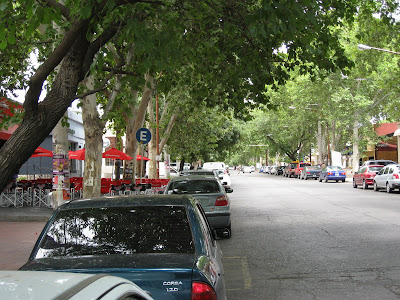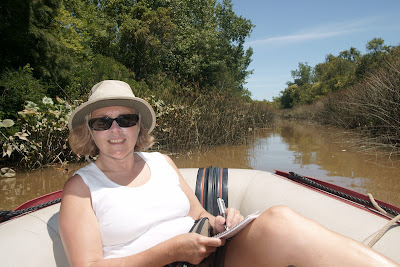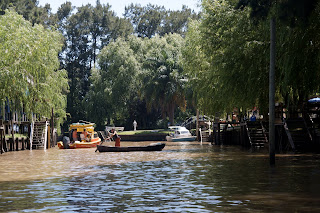
As we sat down at the little restaurant on the town square, the sky over Valle Fertil suddenly turned black. Dark, ominous clouds blotted out the stars over the desert. This did not bode well for our trek into the Valley of the Moon the next morning at 7 a.m.
We ordered BBQ goat and a Quilmes beer like the locals. Everybody here drinks beer, and not the piss ant little bottles we order at home, no these are big boy 1 litre bottles. The beer was cold and refreshing in the heat of the night, although we struggled to finish the whole bottle.
We sat outside on the broken sidewalk because it was slightly cooler, but ready to dash into the hot restaurant if the skies opened. In front of us, at the unlit intersection, motorbikes played chicken with ancient Deux Chevaux Citroens and farm trucks -- Frogger in the dark!
I still haven’t figured out who has the right of way in Argentina. It’s not as simple as in China where the biggest truck or bus wins. There are no lights or stop signs, but there is an order to the chaos as the bikes weave in and out while the cars slow down slightly and then dash through the intersection. In four weeks we've only seen maybe three accidents.
After dinner, we hurriedly walked home in the dark over the broken sidewalks, taking extra care not to fall into one of the water-filled irrigation canals, similar to those in Mendoza, but cruder. Lightning lit up the sky and large rumbles of thunder bounced off the two mountain ranges on either side of town.
But this is a desert, we thought, everything will be fine in the morning.
The last time we tried trekking in the desert was in the Australian Outback. I remember the plane from Sydney landing in a torrential downpour and the Aussie sitting next to me saying, “Not to worry, Mate, it’s all sand out there. It’ll dry up in a coupla’ hours.”
Well he was dead wrong. The “sand” turned into an oily, slippery mud and even the large, 4-wheel drive jeep was unable to get over some of the slick roads. Our trek was cut short, but not until after we had spent a cold night outdoors in swags with the dingoes howling in the background. By morning my feet were soaked where the swag stuck out beyond the overhanging tarp. So much for deserts being dry.
 B
But in Valle Fertil the tour van picked us up at exactly 7 a.m. for the 100 km drive to the Valley of the Moon. There were 11 of us, some Spanish women, a couple from France, and a few Brits (or UKers as they prefer to be called now). They were all young backpackers and staying at youth hostels in town. Fortunately the van picked us Old Farts up first from our two-bedroom cabin with swimming pool. Yea, I know, it's not our style, but even we deserve a bit of luxury now and then.
 W
We had chosen to do both the Ischigualasto and Talampaya Parks in one day because of the amount of driving involved and our tight schedule. The guide books recommend doing Ischigualasto in the morning and Talampaya in the afternoon to take advantage of the way the sun lights up the canyon walls at different times of the day.
I sat in the front and most of my colleagues dozed off in the back because of the early morning start. The driver Marcelo wore dark wraparound sunglasses and I thought for sure he was driving in his sleep because he just stared straight ahead. Occasionally he would refill his drinking gourd with powdered Mate from a pouch with one hand and hot water from a flask he opened with the other hand -- while driving. He slurped it up with a metal straw, but never said a word.
Finally when he started weaving down the road and driving on the wrong side, I decided it was time to ask him a few questions about life in small town Argentina. This woke him up and we talked about the mountains and how he never drove at night because of the goats, horses, wild mules and Guanacos roaming the desert.
Oddly the road was all straight lines again, but never straight across where it could have gone. I asked why and Marcelo said that it was only 36 km as the crow flies to the park, but almost 100 by road. He explained that they had tried to protect the fragile desert environment and that the engineers had also tried to find the most stable ground through the loose desert sand.
As he sped through the deep roller-coaster Badenes, he told me these dry river bed channels can fill up with three meters of water during spring run off and sometimes you could get trapped between two sections and have to wait till the flooding ended. “So what about the rain last night?” I asked. “Don’t worry, that was up in the mountains,” he calmly replied. Well, yeah, I thought, isn’t that where the runoff comes from!
When we finally arrived at Ischigualasto Park, shaken not stirred, a heated debate broke out between the Spanish tourists and the Argentinean park staff. Apparently, it had rained heavily in the park overnight and, sure enough, some of the roads were impassable.
We were given three options: do only part of the tour now, go hiking up one of the nearby mountains and hope the sun dried the trails out by the afternoon, or continue on to the Talampaya Park, where it had not rained, and return in the afternoon to see if the trails were dry here.
The debate was like a session of the UN, switching back and forth between Spanish, English and French and took the better part of 45 minutes while I was watching the best morning light for photos slowly fade away.
It was finally resolved that most of the group would do the hike and Carolann and I and the French couple would continue on to Talampaya, which the others would now miss completely even though they had paid for it. Boy, did they make the wrong choice!
We left for the 45-minute, 90-km drive north to Talampaya with plans to return in two or three hours to meet up with the rest of the group after their hike in the hot desert. A further wait ensued once at the park as we had to wait for enough people to make up a full tour group in the park’s van.
In the end it was very much worth the wait. The park was spectacular.
 T
Talampaya Park is like the Grand Canyon with 200-metre high red sandstone walls, but you drive through the bottom on a wide, dry river bed. The walls are soft and look like they have been sculpted into smooth flowing shapes like sponge cake or sometimes jagged spires like Goya’s cathedral in Barcelona or a Gothic church.

In the background are the high plateaus from Hollywood westerns and a little further off you can see the towering snow capped peak of the Sierra de Famatina.
Standing at the foot of these giant cliffs and watching Condors glide overhead is truly humbling. Even our large van is dwarfed by these impressive, soaring walls.

At one site, a towering chimney, a curved groove cut into the rock face by wind and water, looms overhead. Our guide collected us together in the centre of this pipe and had us shout the names of our countries which caused echoes to reverberate off the walls and down the canyons. Canada generated the most echoes, at four.
At another site, three rock towers were said to resemble the Three Kings, but honestly some of these require a fair bit of imagination to spot.
Slightly easier to identify, however, are rock paintings made by the local Cienga and Aguada natives who lived here over a thousand years ago and probably saw this area in the same way the Aborigines do Uluru in Australia. In fact, the colours and shapes look very much like Rainbow Canyon in that country.
Several hours later we arrived back at Ischigualasto to rejoin our hiking colleagues, tired, thirsty and hungry after their trek up the mountain. They were pretty disappointed to have missed Talampaya.
After a short break for tea, it was determined that the paths had dried out enough and we set off in the van for the tour of Ischigualasto and the Valley of the Moon.
This park, wedged between the Sierra Los Rastros and the Cerros Colorados mountain ranges, was even more varied in its terrain and colours. It is also a famous repository of dinosaur remains.
But it is the weird, alien-shaped formations that really draw the tourists – although very few actually venture this far. White volcanic ash, pale clay or ghostly limestone rocks shaped like a submarine or “El Gusano” (the worm) stand out starkly against a backdrop of red sandstone cliffs in the distance.
Other towers of rocks look very similar to the landscapes of Cappadocia, but on a much smaller scale. Another cluster is called “El Hongo” or Mushroom.
 T
The Valley of the Moon holds other-worldly greyish dunes that resemble a moonscape or, for me, my home town of Sudbury.

One bizarre plateau held a collection of volcanic orbs that looked like bowling bowls or cannon balls scattered across a sandy plain.
As we exited the park the setting sun lit up the surrounding coloured mountains, but we were all too exhausted to get out of the van and admire them. Only the sighting of a small group of Guanacos dashing across the rocky desert raised our energy level. It was a fitting end to an exciting day.

Dan Cooper
 d like the best place to start.
d like the best place to start. 















 There's nothing to do in Mendoza -- other than eat great steaks, drink fabulous Malbec and enjoy life. Actually, in a break from normal custom, some Argentineans actually drink white wine or beer. Yes, life is slow and mellow here.
There's nothing to do in Mendoza -- other than eat great steaks, drink fabulous Malbec and enjoy life. Actually, in a break from normal custom, some Argentineans actually drink white wine or beer. Yes, life is slow and mellow here.































